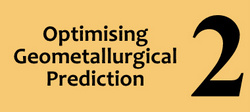Transforming the Mining Value Chain
Theme 2- Optimising Geometallurgical Prediction
 Quantifying the texture, mineralogy and mineral chemistry of rocks in the mine environment contributes to the prediction of processing performance and value of mine products. The element deportment controls the grade and recovery of mine concentrates. The value of the concentrate is also affected by the presence of penalty elements, such as Sb, As, F and Hg, of which permissible abundances are subject to strict environmental monitoring. The risks of mine failure and environmental disasters are far greater without a complete understanding of the mineral deportment of all elements of concern. However many mining operations have commenced without such knowledge. Theme 2 will develop the techniques and protocols for rapid trace metal deportment in a range of ore types that can be implemented at the mine planning stage and carried through to waste disposal and ultimately to mine site rehabilitation (Theme 3).
Quantifying the texture, mineralogy and mineral chemistry of rocks in the mine environment contributes to the prediction of processing performance and value of mine products. The element deportment controls the grade and recovery of mine concentrates. The value of the concentrate is also affected by the presence of penalty elements, such as Sb, As, F and Hg, of which permissible abundances are subject to strict environmental monitoring. The risks of mine failure and environmental disasters are far greater without a complete understanding of the mineral deportment of all elements of concern. However many mining operations have commenced without such knowledge. Theme 2 will develop the techniques and protocols for rapid trace metal deportment in a range of ore types that can be implemented at the mine planning stage and carried through to waste disposal and ultimately to mine site rehabilitation (Theme 3).
Currently deportment questions are routinely addressed using scanning electron microscopy (SEM) based mapping systems (QEMSCAN, MLA). Our research program will be focussed on developing new standardised analytical protocols determining multi-element deportment in ores. Our approach involves combining the existing capabilities of SEM with the low detection limits of LA-ICPMS. Three possible scenarios of element deportment will be considered:
i) Trace element is concentrated as a major (stoichiometric) element in a trace mineral: Examples: Au in gold and electrum; As in arsenopyrite, cobaltite, realgar, orpiment, enargite;
ii) Trace element is concentrated as a minor element in a minor mineral: Examples: F in apatite, mica, amphibole, tourmaline: Cd in sphalerite;
iii) Trace element is dispersed at trace level in a common mineral: Examples: Au in pyrite and arsenopyrite; U in feldspar. In many cases the element of interest may be distributed across more than one scenario.
With the ability to accurately measure deportment on a significant number of samples, data mining techniques can be used to search for correlation with the large set of categorical and nominal data available in the mine database, including data extracted from core imaging.
